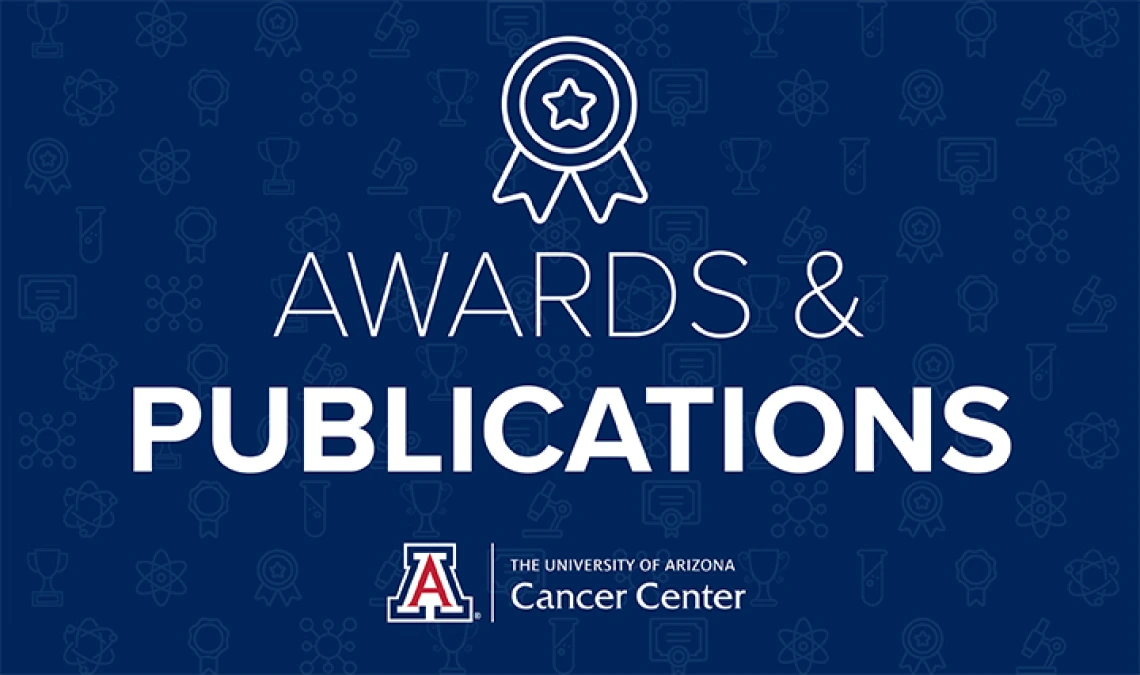UArizona Cancer Center Awards & Publications (September 2020)
Finding Tomorrow’s Treatments, Today, Awards Update: September 2020

Awards Update: September 2020

Cancer Biology Program, Research Member
Project Title: Redox and Protein Homeostasis in Arsenic Tumorigenicity
Grant Number: 1R01ES031463-01A1
Administering Institute: National Institute of Environmental Health Sciences (NIEHS)
Funding: $1.5 million (5 years)
Project Research: Arsenic is an environmental carcinogen that affects 200 million people worldwide. Yet, the underlying cause of arsenic mediated carcinogenesis remains without a molecular explanation. Dr. Chapman’s studies will explore the relationship between redox and protein homeostasis and how this can lead to arsenic-derived tumors.
Dr. Chapman Says: “This grant is related to the effects arsenic has on cellular quality control and is an extension of what Dr. Donna Zhang and I found in a recently completed R01 grant. Our data strongly showed that p97 negatively regulate NRF2 and NRF2 positively regulates p97, creating a feedback loop. This also means unchecked, high levels of NRF2 result in a hyper protected environment that allows cells to survive very high oxidative and proteotoxic stress, giving them a survival advantage. The point of this new grant is to explore whether that is necessary and sufficient to allow transformation of cells to become malignant.”

Cancer Prevention and Control Program, Research Member
Project Title: Adipose and Lean Soft Tissue Depots, Cancer Risk and Mortality in Postmenopausal Women
Grant Number: 1R01CA253302-01
Administering Institute: National Cancer Institute (NCI)
Funding: $1.05M (3 years)
Project Research: The study will use innovative software to derive new abdominal lean soft tissue data from historic dual-energy X-ray absorptiometry scans in the Women's Health Initiative (approx. 11,000 women with repeat scans over 9 years; 25 years of follow-up) and leverage recently derived abdominal visceral and subcutaneous adipose tissue values obtained using the same innovative software. These new data will be used to address essential unanswered questions on the topic of obesity and cancer by quantifying the relationship between these measures with risk of cancer in postmenopausal women, and cancer related deaths as they age. The study will inform etiological understanding, improve risk assessment, and most importantly, enhance ability to target interventions and cancer prevention efforts.
Dr. Bea Says: “It is commonly known that BMI (body mass index) is associated with around a dozen cancers. So, we know obesity is a problem, but I think we can do a better job at differentiating the high-risk groups and potentially have more targeted approaches to mitigate risks if we understand the contributions of visceral fat, subcutaneous fat and muscle, instead of simply classifying on height and weight. We want to get a more specific measure of actual adiposity to then differentiate risk in patients.”

Cancer Prevention and Control Program, Research Member
Project Title: A Mixed Method to Identify Causes of Kidney Cancer Surgical Disparities in Arizona
Grant Number: 1R21CA248361-01
Administering Institute: National Cancer Institute (NCI)
Funding: $388,482 (1 year)
Project Research: The study’s goal is to understand the patterns of kidney cancer surgical disparities and identify causes of disparities through in-depth interviews with kidney cancer patients and community members without cancer. Dr. Batai will also conduct analysis of kidney cancer patients’ clinical data at local, state and national levels using data from Banner University Medical Center, Arizona Cancer Registry and the National Cancer Database.
Dr. Batai Says: “Early detection and timely surgical treatment with a minimally invasive surgical method would likely reduce kidney cancer health disparities. Through this research project, we will try to understand the patterns of kidney cancer surgical disparities, such as differences in surgical treatments in which patients receive, and identify the causes of such gaps. We hope to develop recommendations and/or strategies to reduce kidney cancer disparities.”
Publications Update: September 2020

Chief, Division of Gastroenterology
Cancer Biology Program, Research Member
Publication: GUT
Overview: Dr. Merchant’s research article used mouse models and whole genome profiling to characterize a myeloid-derived suppressor cell (MDSC), which also resulted in the identification of a potential biomarker that appears in patients before cancer develops. The important application related to indigenous populations is that given their distance from major medical centers, biomarkers could be used to screen patients for pre-neoplastic changes in the stomach that will need diagnostic procedures, such as endoscopy, close monitoring for progression to cancer or treatment. Dr. Merchant’s lab has a subproject in the U54 grant (Partnership for Native American Cancer Prevention) to study detection of the microRNA described in the GUT paper in the Navajo population infected with H. pylori.
Dr. Merchant Says: “The biggest impact is that we've identified a microRNA that indicates that there is a particular cell type that is in the stomach that correlates with early, preneoplastic changes. The study arose out of basic science mouse models, and then we asked the question of whether this biomarker is present in human plasma. We were able to detect it, so that is obviously very interesting, but it's retrospective. Now the question is, can we look at this more prospectively in different patient populations?”

Chief, Section of Gastrointestinal (GI) Medical Oncology
Medical Director, Clinical Trials Office
Therapeutic Development Program, Research Member
Publication: The Lancet
Title: Pancreatic Cancer
Overview: Dr. Shroff’s paper is a highly comprehensive summation of impactful research in the area of pancreatic cancer over the last five to seven years. Pancreatic cancer is projected to be the second-leading cause of cancer death by 2030. Surgery is the only curative therapy, but only about 20% of patients can be offered a curative resection. The paper details epidemiology of the disease, including its rise among cancer-related deaths, as well as outlining key risk factors, which historically has been smoking but now includes obesity, diabetes, metabolic syndrome and familial history. Other areas of focus include discussion of two chemotherapy combinations in metastatic patients as the current standard of care for the disease. While surgery offers a potential for cure, multimodality treatments have demonstrated survival benefits beyond surgery alone. In fact, perioperative therapy before and/or after surgery is becoming more common. In addition, the paper highlights emerging novel targets and therapeutic approaches in the metastatic, including the FDA approval of a PARP inhibitor (olaparib) for BRCA positive patients. Lastly, the paper examines the challenges of immunotherapy in treating pancreatic cancer.
Dr. Shroff Says: “In terms of immunotherapy, the therapies that are working well in melanoma, and lung cancer, for example, have not played out very well in pancreatic cancer. We think it's because pancreatic cancer is not an inherently immunogenic tumor. This is likely due to the dense stroma and the surrounding tumor microenvironment which suppress the activation of immune cells and the kind of immune cell infiltration needed to see the efficacy of traditional immunotherapy. However, we are excited here at the UArizona Cancer Center to have approval for an investigator-initiated trial that is based on our homegrown science and is testing an immunotherapy combination that we hope will be much more effective for pancreatic cancer patients.”








